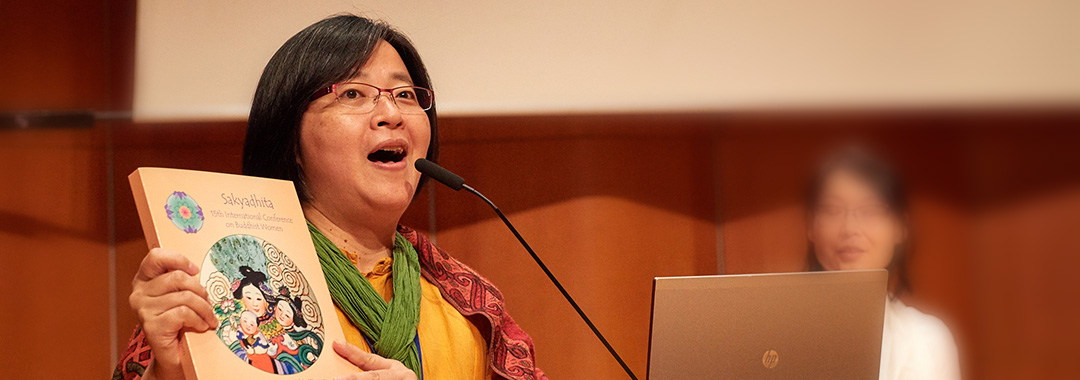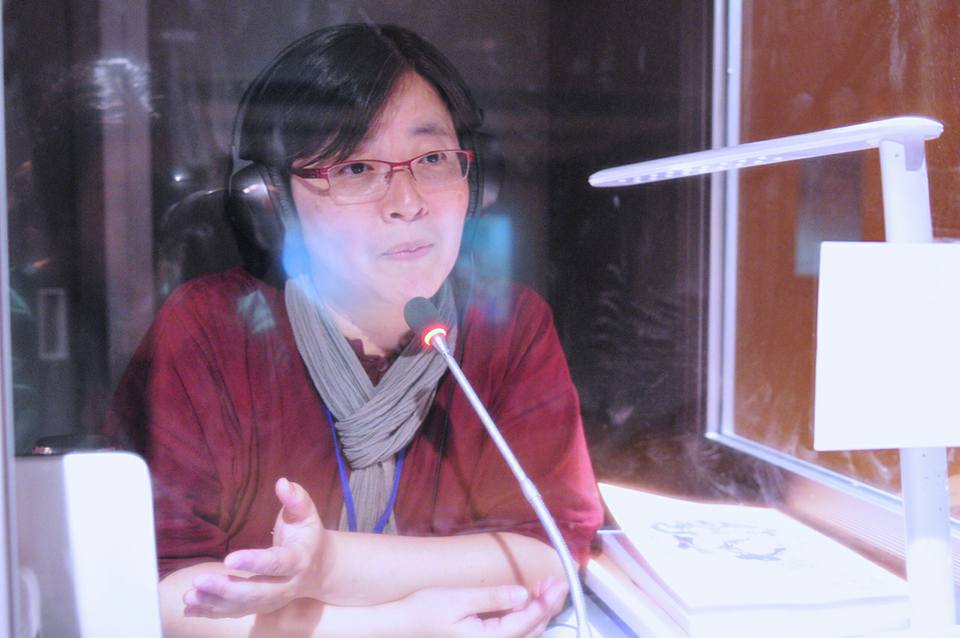
[시드니와 함께하는 세계 속 붓다의 딸, 5탄]
인터뷰: 샤카디타 타이완 크리스티 장 Interview with Christie Chang
크리스티 장은 샤카디타 국제지부의 전 회장이며 샤카디타 타이완의 회장이다. 국제학생교류 기관인 CIEE 대만지부의 책임자이기도 하다.
*기자: 시드니 톰슨, *번역: 김은희
시드니 Sydney:
![]() 자기 소개를 부탁드립니다.
자기 소개를 부탁드립니다.
Could you please introduce yourself?
크리스티 장 Christie Chang:
![]() 저의 이름은 張玉玲 (장유링)이고, 고등학교 때부터 “크리스티(Christie)”라는 영어이름을 사용하였습니다. 타이베이에서 태어나 대만국립대학교 외국어학과에서 학사 학위를 받았고, 미국의 대학원에서 공부하기 전에 영어 교사와 편집인으로 일했습니다. 하와이대학교에서 언어학 전공으로 석사, 박사학위를 받았으며 5년간 학부 과정에서 언어연구학개론을 가르쳤습니다. 2001년에 대만으로 돌아와 국제교육교류협의회(International Educational Exchange Council, CIEE, www.ciee.org)에서 일했습니다. 국제교육을 통한 세계평화를 위해 일하는 이 조직은 미국에 기반을 둔 초기 NGO/NPO 입니다. 또한 대만국립대학교(National Taiwan University)와 정치국립대학교(National Chengchi University, 이곳에 CIEE 대만지부의 사무실이 있음)에서 조교수로 언어학개론, 영어구술연습, 영어작문, 번역, 중국어교육과 같은 다양한 과목을 가르쳤습니다.
저의 이름은 張玉玲 (장유링)이고, 고등학교 때부터 “크리스티(Christie)”라는 영어이름을 사용하였습니다. 타이베이에서 태어나 대만국립대학교 외국어학과에서 학사 학위를 받았고, 미국의 대학원에서 공부하기 전에 영어 교사와 편집인으로 일했습니다. 하와이대학교에서 언어학 전공으로 석사, 박사학위를 받았으며 5년간 학부 과정에서 언어연구학개론을 가르쳤습니다. 2001년에 대만으로 돌아와 국제교육교류협의회(International Educational Exchange Council, CIEE, www.ciee.org)에서 일했습니다. 국제교육을 통한 세계평화를 위해 일하는 이 조직은 미국에 기반을 둔 초기 NGO/NPO 입니다. 또한 대만국립대학교(National Taiwan University)와 정치국립대학교(National Chengchi University, 이곳에 CIEE 대만지부의 사무실이 있음)에서 조교수로 언어학개론, 영어구술연습, 영어작문, 번역, 중국어교육과 같은 다양한 과목을 가르쳤습니다.
My Chinese name is 張玉玲 (Chang, Yu-Ling), and my English name has been “Christie” since high school. I was born and raised in Taipei, received a BA degree from the Department of Foreign Languages and Literatures from National Taiwan University and worked as an English teacher and editor before pursuing graduate programs in the US. I received both MA and Ph.D. degrees in Linguistics from the University of Hawai’i, where I also taught Introduction to the Study of Language at the undergraduate level for five years. I came back to Taiwan in 2001 to work for the Council on International Educational Exchange, or CIEE (www.ciee.org), one of the earliest NGOs and NPOs based in the US aiming to work for world peace through international education. I also taught various subject matters as an Adjunct Assistant Professor at National Taiwan University as well as at National Chengchi University (where CIEE Taipei’s office is), including: Introduction to Linguistics, English Oral Drills, English Composition, Translation, Teaching Chinese as a Second/Foreign Language, and so on.
시드니:
![]()
처음으로 불교를 알게된 일을 말씀해주세요.
How did you first come to learn about Buddhism?
크리스티:
![]() 저는 불교권 문화인 대만에서 자라 항상 불교를 접해왔습니다. 바로 옆집이 기독교 교회였었고, 말 그대로 모든 영적 전통에 대해 호기심을 가지고 있었기에 여러 종교를 탐구했죠. 그러다 1995년 하와이의 호놀룰루에서 비구니 스님을 만나 불자가 되었습니다. 저는 탐구자였죠. 말하기에는 긴 이야기입니다. 그 이야기를 다 하려면 책을 써야 할 정도입니다.
저는 불교권 문화인 대만에서 자라 항상 불교를 접해왔습니다. 바로 옆집이 기독교 교회였었고, 말 그대로 모든 영적 전통에 대해 호기심을 가지고 있었기에 여러 종교를 탐구했죠. 그러다 1995년 하와이의 호놀룰루에서 비구니 스님을 만나 불자가 되었습니다. 저는 탐구자였죠. 말하기에는 긴 이야기입니다. 그 이야기를 다 하려면 책을 써야 할 정도입니다.
I have always been exposed to “Buddhism” since I grew up in a “Buddhist culture” in Taiwan, although I did live right next to a Christian church and was curious about literally all spiritual traditions, so I have explored many different religions too. However, I did not become a Buddhist until I met my Bhiksuni teacher in Honolulu, Hawai’i, in 1995. I have been a searcher, you see. It’s a long story to tell, and I am afraid I will have to write an entire book about it!
시드니:
![]()
샤카디타 국제지부(Sakyadhita International)의 전직 부회장으로 활동하게 된 계기는 무엇입니까? 그 자리가 당신을 어떻게 변화시켰는 지도 알려주세요.
What motivated you to act as former VP of Sakyadhita International? How has that position shaped you?
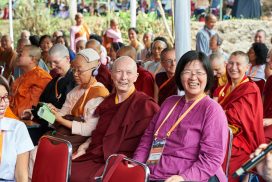
크리스티:
![]() 제 마음 속의 저는 항상 자원봉사자였습니다. 저는 저를 위해 어떤 거창한 직함을 가지려고 한 것도 아니었고, 다른 분들과 똑같은 일들을 했고 잘 운영하려고 노력했습니다. 그럼에도 불구하고 2005-2009년 샤카디타 국제지부의 부회장으로 일하면서 많은 성장을 했고 그런 준비 기간을 거쳐 2009-2013년 회장이 되었습니다. 그 결과 저는 제 능력에 대한 더 많은 가능성을 알게 되었습니다. 또 저의 능력을 향상시키고 모든 사람들에게 봉사하고 특히 사랑하는 여성불자들에게 혜택을 줄 수 있다는 것을 알게 되었습니다.
제 마음 속의 저는 항상 자원봉사자였습니다. 저는 저를 위해 어떤 거창한 직함을 가지려고 한 것도 아니었고, 다른 분들과 똑같은 일들을 했고 잘 운영하려고 노력했습니다. 그럼에도 불구하고 2005-2009년 샤카디타 국제지부의 부회장으로 일하면서 많은 성장을 했고 그런 준비 기간을 거쳐 2009-2013년 회장이 되었습니다. 그 결과 저는 제 능력에 대한 더 많은 가능성을 알게 되었습니다. 또 저의 능력을 향상시키고 모든 사람들에게 봉사하고 특히 사랑하는 여성불자들에게 혜택을 줄 수 있다는 것을 알게 되었습니다.
In my mind, I have always been a volunteer. I never intended to assume any title and, for me, it is all the same tasks to do and all the same errands to run. Being the VP of Sakyadhita International from 2005-2009 has, nevertheless, definitely offered important training for me and subsequently prepared me to serve as the President of Sakyadhita from 2009-2013, which has, in turn, opened my eyes and mind to further possibilities as well as enhanced my capacity and capabilities to serve and benefit all, especially my dear Buddhist Sisters.
시드니:
![]()
샤카디타 타이완(Sakyadhita Taiwan)의 소개를 해주세요.
Could you please introduce Sakyadhita Taiwan?
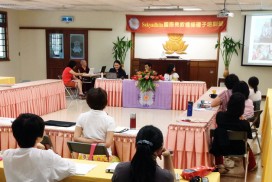
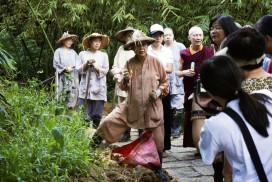
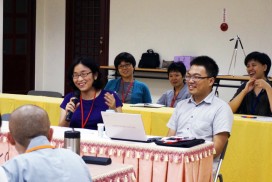
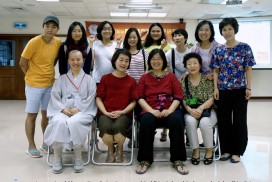
크리스티:
![]()
2008년 창립한 샤카디타 타이완은 샤카디타 국제지부의 첫 번째 "지부(National Branch)"입니다. 이것은 기본적으로 "본보기 사례"(물론 원인과 조건이 성숙한 결과이기도 합니다)입니다. 제가 회장으로 있는 동안 샤카디타 지점/지부를 설립하기 위해 사람들이 따라 할 수 있는 초안을 바탕으로 한 ’본보기 지부’가 필요했습니다. 샤카디타 타이완 이전의 대만에는 여러 불교 단체 산하에 여성부를 포함하는 크고 작은 단체들이 이미 많이 있었습니다. 따라서 대만에서 샤카디타 국제지부를 창립한 목적은 결코 이 작은 섬에 또 하나의 불교 단체를 추가하려는 것이 아니었습니다. 대만의 초기 샤카디타 대회 참가자 2명은 대만의 불자들이 영어교육도 받고 훌륭한 번역가도 될 수 있다는 것을 알게 되었습니다. 따라서 샤카디타 타이완은 이 작은 번역자 모임에 의해 실제로 처음 제안되었으며 지금까지도 번역가 및 번역 교육은 샤카디타 타이완의 중요한 사업으로 남아 있습니다.
샤카디타 국제지부와 마찬가지로 샤카디타 타이완은 NGO/NPO로 대만 정부에 등록되어 있지만 다소 느슨한 네트워크 입니다. 앞에서 언급했듯이 대부분의 불교여성들은 이미 하나 또는 그 이상의 지역의 불교 종파나 단체에 소속되어 있고 그쪽 일로 분주한데다가, 번역가의 본질상 프리랜서로 활동합니다. 그럼에도 불구하고 우리는 현지 불교공동체에서 매우 잘 알려져 영어를 사용하는 법사가 필요한 불교행사를 도와주거나, 불교회의 통역가 또는 불교행사MC로 활동하고 있습니다. 샤카디타 타이완은 국제 불교공동체에서 활동적으로 일하면서도 현지 불교단체, 특히 대만 중부의 남림사원(南林尼僧院, Nan Lin Bhiksuni Sangha)과 북부의 보의원(法雨山普宜苑, Puyi Yuan)과 같은 비구니 단체와 좋은 관계를 유지해 왔습니다. 몇 년 전 샤카디타 타이완이 개최한 국제번역안거(International Translation Retreat)동안 한국과 다른 나라의 샤카디타 번역가들이 보의원에서 머물렀습니다. 최근 샤카디타 타이완은 보의원의 어린이 여름 캠프를 위한 교육프로그램 설계를 지원하기도 했습니다. 샤카디타 타이완은 2002년 대만에서 열린 제7차 샤카디타 대회의 주제인 “모든 세계를 연결시키는 것”에 도움이 되는 인연의 흐름을 계속 따르고 있습니다.
Sakyadhita Taiwan became the very first “National Branch” of Sakyadhita International in 2008 as basically an “example” (and of course as a result of causes and conditions ripening too), because, back then, we were in need of a “sample branch” to include in the drafted guidelines for people to follow in order to establish a Sakyadhita branch/chapter during my term as the President of Sakyadhita. Before Sakyadhita Taiwan, there were way too many Buddhist groups in Taiwan already, big and small, including many women’s divisions under various Buddhist associations. So, the aim of starting a branch of Sakyadhita in Taiwan has never been to just add one more Buddhist organization to this small island. Identifying strongly with Sakyadhita International’s unique mission and vision, and hoping to bring more Taiwanese Buddhist women to the Sakyadhita conferences, a couple of early Sakyadhita conference participants from Taiwan observed that Buddhists in Taiwan can use some English training as well as good translators; therefore, the Sakyadhita Taiwan branch was actually initially proposed by this small group of translators, and even to this day, translators and translation training remain the backbone of Sakyadhita Taiwan.
Like Sakyadhita International, Sakyadhita Taiwan remains a rather loose network although it is registered with the local Taiwanese government as an NGO/NPO. Most Buddhist women, as mentioned, already have one (or more) local Buddhist orders or organizations they belong to and are busy with them, and translators are pretty freelance in nature. Nevertheless, we are very well-known and consulted with in the local Buddhist community when it comes to finding Dharma English teachers, Buddhist conference translators, or MCs for any Buddhist events. Sakyadhita Taiwan has been active in the international Buddhist community while maintaining good relations with local Buddhist organizations, especially some nunneries, such as Nan Lin Bhiksuni Sangha in central Taiwan and Puyi Yuan in Taipei, where many Korean and international Sakyadhita translators have stayed and/or visited during the International Translation Retreat held by Sakyadhita Taiwan years ago. Lately, Sakyadhita Taiwan has also been invited to assist in training and designing programs for the children’s summer camp at Puyi Yuan. Sakyadhita Taiwan continues to follow its karmic flow in helping to “bridge worlds,” the theme of the 7th Sakyadhita conference in Taiwan 2002, with the aspiration to benefit all sentient beings.
시드니:
![]()
대만의 젊은 사람들을 포함한 재가불자들은 얼마나 불교에 의해 동기부여를 받거나 또 얼마나 불교에 헌신적인가요?
How are Taiwanese Buddhist laypeople so motivated by, or devoted to, Buddhism, including young people?
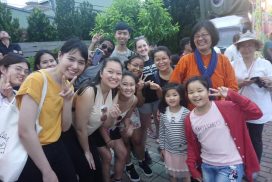
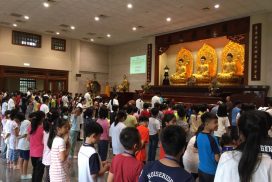
크리스티:
![]()
불교는 사회적으로나 개인적으로 효과가 확실하잖습니까? 대만 재가불자들이 불교에 헌신하도록 동기를 부여하는 다양한 원인과 조건이 있지만, 결국, 동기 부여 및 또는 헌신은 결국 자신에게 효과가 나타날 때 계속 지속될 수 있잖아요. 안그렇습니까?
대만의 여러 지역에서는 공승제(Sanghadana)와 같은 대규모 행사가 조직적으로 운영됩니다. 매번 2만 명이 넘는 사람들이 모이며 각종 행사가 성황리에 거행됩니다. 대만 중부에서 열리는 공승제는 30년의 역사를 가지고 있으며, 그동안 대만 전역에서 많은 자원 봉사자와 군중을 꾸준히 끌어 들이고 있다는 것을 생각해보세요. 특히 작년에는 두 차례의 대형 태풍이 닥쳤지만 그 사이에 행사는 예정대로 거행되었습니다. 놀랍게도 첫 번째 태풍은 그냥 멈추고 태양이 빛나서 행사는 순조롭게 진행되었으며 두 번째 태풍은 행사가 끝나고 사람들이 집에 도착한 후에 불어 닥쳤습니다. 대만 재가불자들이 내년에도 공승제에 계속해서 참여할까요? (물론 그렇습니다)
Well, Buddhism simply works!!! Of course, there are various causes and conditions that motivate Taiwanese Buddhist laypeople to become devoted to Buddhism, but, at the end of the day, motivation and/or devotion can only last if what you turn to works for you, right!?
Big events like Sanghadana, which are so very well organized in various parts of Taiwan and which typically draw over 20,000+ people in each gathering, function in many different ways. Imagine how the Sanghdana held in central Taiwan, and which has a history of now 30 years, has continued to attract big groups of volunteers and crowds from all over Taiwan even when it took place between two super typhoons last year! Incredibly, the first typhoon simply stopped, the sun shined, and the event went on smoothly, and the second typhoon only hit after everyone was safely at home early the following morning. Do you think Taiwanese Buddhist laypeople will continue to join this Sanghadana next year?
시드니:
![]()
대만 불교는 다른 문화의 불교와 어떻게 다릅니까?
How is Taiwanese Buddhism different from Buddhism practiced in other cultures?
크리스티:
![]()
대만에서 가장 널리 퍼져있는 형태의 불교는 정토계와 중국선종(Chinese Chan)(선/젠)이 합해진 것입니다. 대만 사찰에 가면 "아미토포(Amitofo, 중국 공식 언어로 발음되는 아미타불)" 또는 "아미도후(Amidohu, 아미타불의 대만식 발음으로 중부와 남부 대만에서 많이 사용)"이라는 말로 인사하는 사람들을 볼 수 있습니다. 티베트 불교도 최근에 많은 불자들을 끌어 들이고 있습니다. 한편 다양한 스타일의 방법을 사용하는 명상안거가 대만에서 인기가 있습니다. 염불 안거, 중국선 안거, 위빠사나 센터, 요가 또는 밀교안거 등이 있으며 대만의 여러 지역에서 수시로 개최됩니다. 경험 많은 수행자들은 하나의 종파 또는 방법에 초점을 맞추고 그것을 깊게 수행하는 것을 강조하지만 대만 불교도들은 새롭고 다양한 수행 방법에 매우 개방적입니다. 아직도 대만에서는 거의 모든 형태의 불교를 볼 수 있습니다.
The most prevalent form of Buddhism in Taiwan is the combination of the Pure Land School plus the Chinese Chan (Seon/Zen) School. In Taiwan, you can pass in any Buddhist temple by greeting people with “Amitofo” (i.e. “Amitabah Buddha” pronounced in Mandarin Chinese, the official language) or “Amidohu” (“Amitabah Buddha” pronounced in Taiwanese, the more popular form if you travel to central or southern Taiwan). Vadriyana Buddhism has attracted many followers in recent years too. Meanwhile, meditation retreats, using various methods in all different styles are popular in Taiwan too. You can find Buddha-chanting retreats, Chinese Chan meditation retreats, Vipassana Centers, Yoga and/or Tantric Practice retreats, and more taking place from time to time in different parts of Taiwan. The Taiwanese Buddhists are very open to new and diverse ways of practice although many experienced practitioners have also emphasized the importance of focusing on and going deep enough into one particular school or method first. Still, one can find pretty much all forms of Buddhism practiced in Taiwan.
시드니:
![]()
대만 불교가 직면하고 있는 문제점은 무엇입니까?
What are some challenges, if any, that Buddhism faces in Taiwan?
크리스티:
![]()
아시아의 다른 여러 나라와 마찬가지로, 대만의 불교는 청년들을 충분히 끌어 들이지 못하고 있다는 것이 당면한 큰 문제입니다. 대만의 크고 유명한 많은 불교 단체들이 있고 각종 활동을 펼치고 있지만, 보다 더 창의적이고 효과적으로 시기를 잘 맞추어 젊은 세대에 다가가야 합니다.
Like elsewhere in Asia, Buddhism in Taiwan faces the same challenge of not attracting enough young people. Despite the many big and famous Buddhist groups and activities in Taiwan, Buddhist teachings need to reach out to and catch up with the younger generation in a more creative, effective, and timely manner.
시드니:
![]()
젊은 세대에게 어떤 불교의 메시지를 전달하고 싶습니까?
What Buddhist message do you want to pass on to the younger generation?
크리스티:
![]()
부처님 가르침을 계속 펼쳐보세요. 이러한 소중한 가르침을 계속 활용하고 실천해보세요. 너무 빨리 쉽게 포기하지 마십시오. 생각해보십시오. 부처님의 가르침이 2600년 이상 이어져왔고, 널리 퍼졌으며 인류 역사를 통틀어 많은 훌륭하고 멋진 인물들(요즘 할리우드 스타를 포함하여!)에게 존경과 지지를 받았다는 것을 생각해 보십시오. 그렇다면 부처님의 가르침에 무엇인가 훌륭한 것이 있지 않을까요? 부처님의 가르침을 듣고, 되새겨보고, 수행해 보십시오! 이 수행들이 여러분에게 효과가 있는지 보세요! 샤카디타 코리아, 샤카디타 타이완 및 샤카디타 국제지부와 같은 지원 커뮤니티를 통해 시간을 내어 부처님의 가르침을 수행해 보십시오. 당신은 결코 혼자가 아니며 수행공동체와(다시) 함께 할 때 결코 외롭지 않습니다. 그저 시도해 보세요! 여러분의 "선우(善友 ,kalyanamitra)", 여러분의 도반인 우리는 여기에 있으며 여러분에게 사랑과 기원을 보냅니다. 당신이 어떤 지원을 사용할 수 있다고 생각한다면 알려주세요! 건배! ^ _ ^
Do give Buddhist teachings a try- try to apply these precious teachings and do practice them; never give up so quickly and easily. Think about it- if the teachings have survived for over 2600 years, have spread far and wide, and have been respected and upheld by so many cool and awesome people throughout human history (including some Hollywood stars these days!), there must be something to it!? Try to hear, reflect upon, and practice the teachings! See whether they work for you! Try to give yourself some time and try to practice the teachings with a community of support, such as Sakyadhita Korea, Sakyadhita Taiwan and/or Sakyadhita International— you are never alone and you can never be lonely when you are (re-)connected with the community of Dharma practices! Just try! We are here, your “kalyanamitra”, your Dharma friends, sending you love and all our best wishes. Let me know if you feel you could use some support! Cheers! ^_^
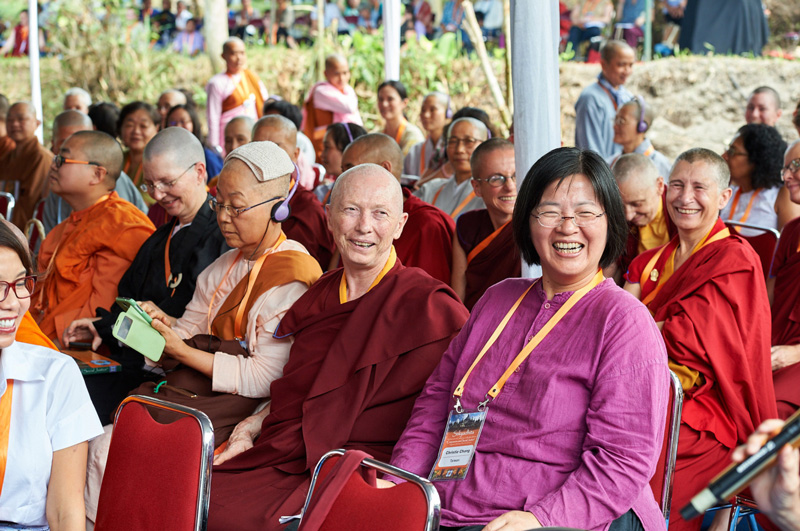
크리스티 장은 샤카디타 국제지부의 전 회장이며 샤카디타 타이완의 회장이다. 국제학생교류 기관인 CIEE 대만지부의 책임자이기도 하다.
 *시드니 톰슨은 샤카디타 코리아 홍보간사를 맡고 있으며, 샤카디타 코리아 뉴스레터 영문판 에디터로 일하고 있습니다.
*시드니 톰슨은 샤카디타 코리아 홍보간사를 맡고 있으며, 샤카디타 코리아 뉴스레터 영문판 에디터로 일하고 있습니다.
*Sydney Thompson is Sakyadhita Korea’s publicity assistant and writer for Sakyadhita Korea’s English content.

